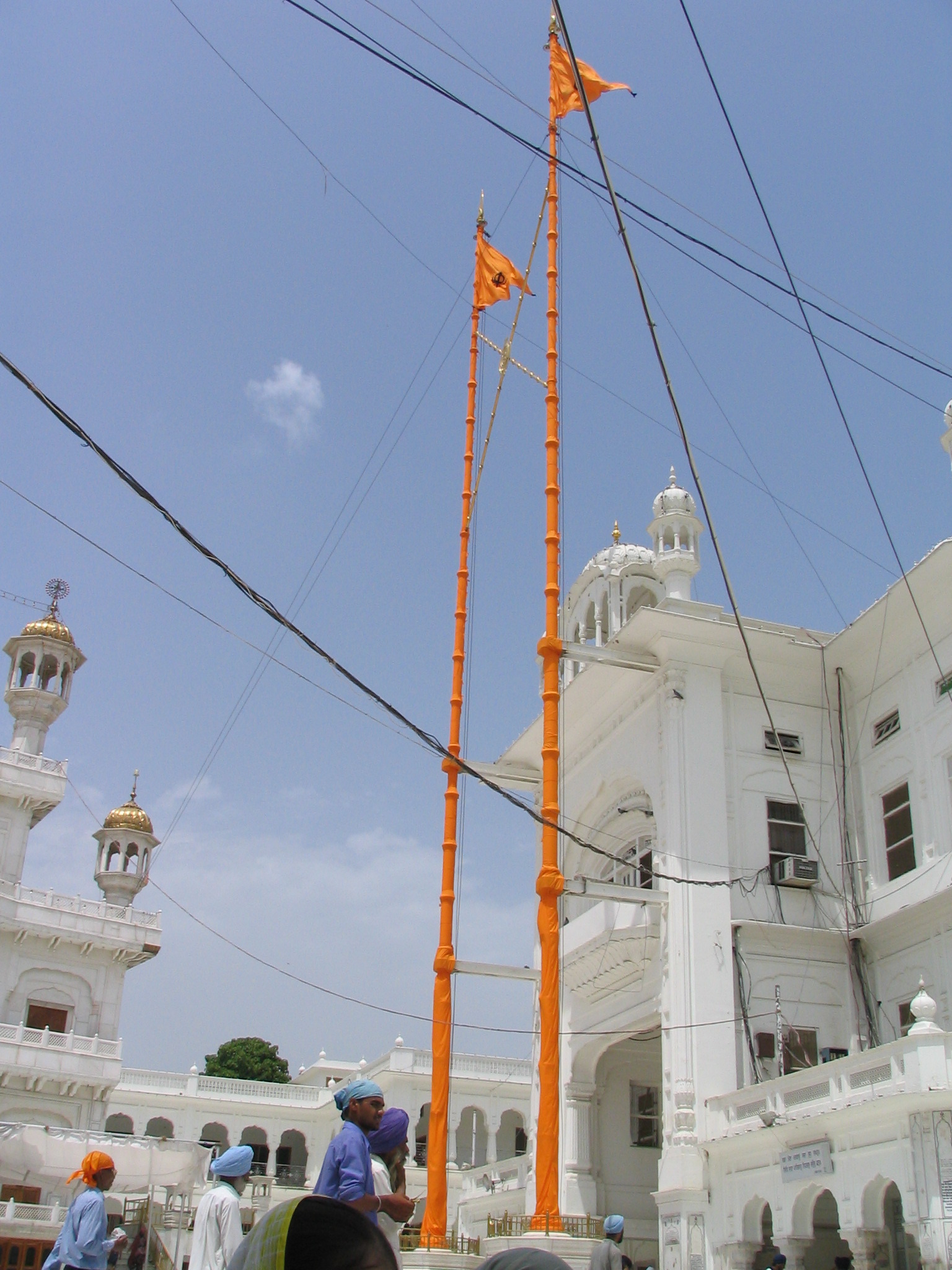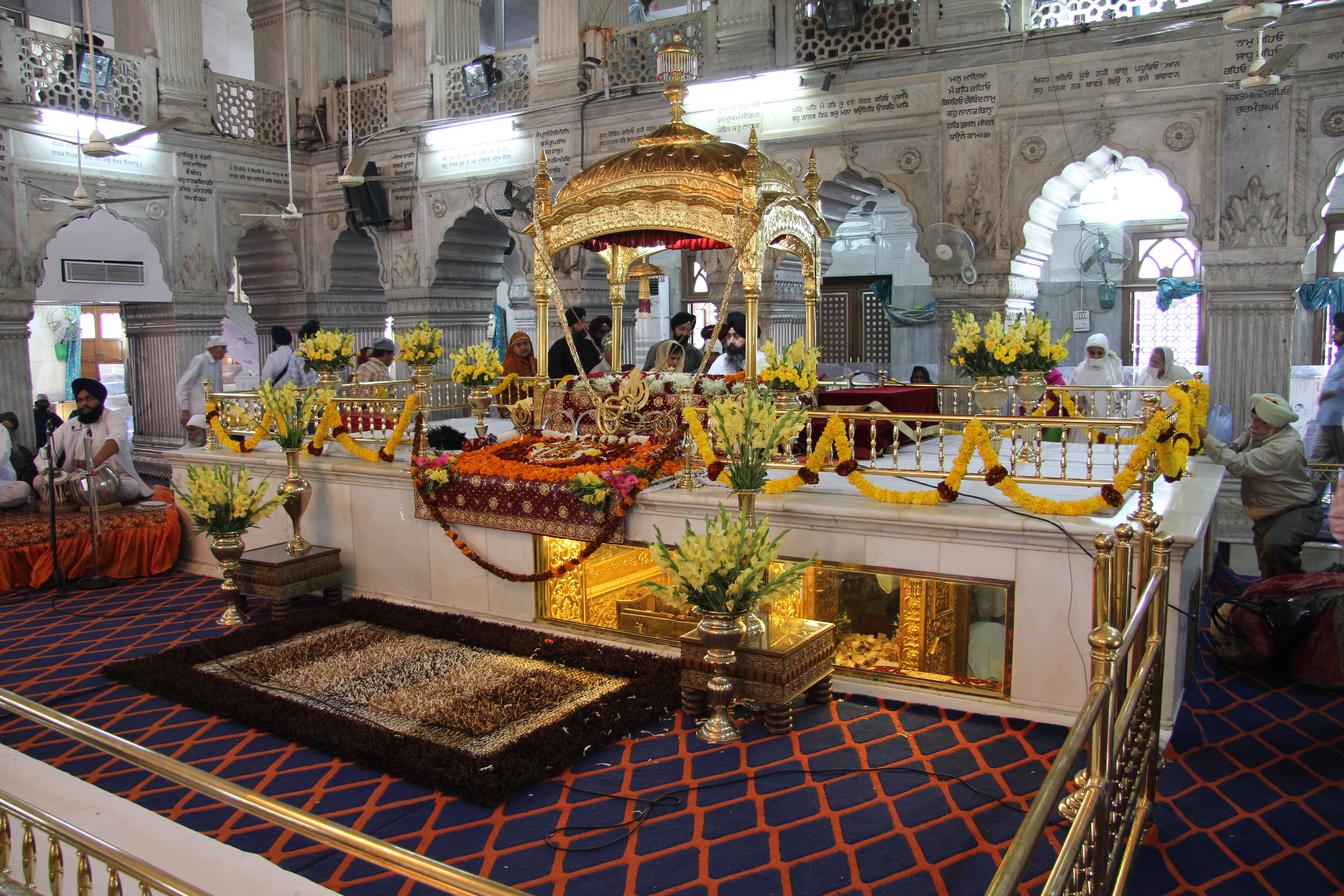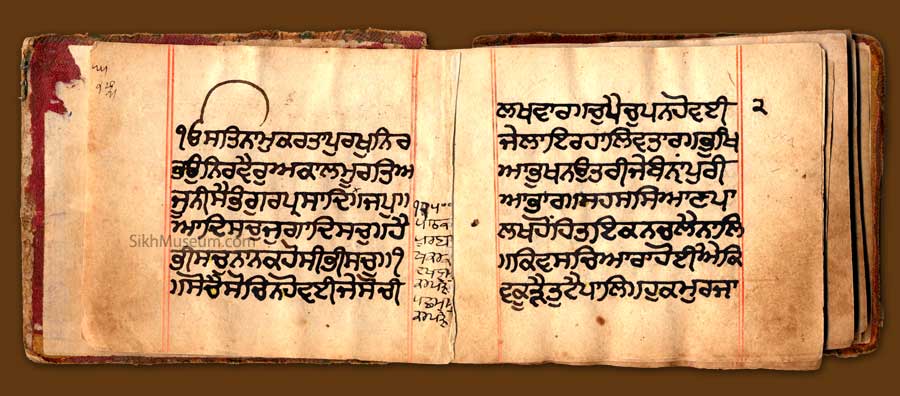|
Guru Nanak Nishkam Sevak Jatha
The Gurdwara Sahib is a Sikh place of worship or Gurdwara in Handsworth, Birmingham, England. It was built in the late 1970s under the spiritual guidance of Puran Singh (d. 1983) and the leadership of Norang Singh (d. 1995). The Spiritual leadership of the jatha is now continued through the vision of Mohinder Singh. The gurdwara spans an area of about 25,000 square meters and the building is four stories high. There are five main Darbar Halls and three Langar Halls. There are approximately 100 rooms, most of which are for the sangat who want to stay at the Gurdwara for the night and have facilities for sleeping and washing. The main Darbar is used for continuous Akhand Path recital. A new Paath is started on Monday, Wednesday and Friday mornings, unless a Samagam "community meeting" is under way. At Samagam programs, there is Sampat Paath recitation of a shabda: each line of the gurbani is followed by a sampat. Sampath Paath usually takes eleven days of continuous reading. S ... [...More Info...] [...Related Items...] OR: [Wikipedia] [Google] [Baidu] |
Sikh
Sikhs ( or ; pa, ਸਿੱਖ, ' ) are people who adhere to Sikhism, Sikhism (Sikhi), a Monotheism, monotheistic religion that originated in the late 15th century in the Punjab region of the Indian subcontinent, based on the revelation of Guru Nanak. The term ''Sikh'' has its origin in the word ' (), meaning 'disciple' or 'student'. Male Sikhs generally have ''Singh'' ('lion'/'tiger') as their last name, though not all Singhs are necessarily Sikhs; likewise, female Sikhs have ''Kaur'' ('princess') as their last name. These unique last names were given by the Gurus to allow Sikhs to stand out and also as an act of defiance to India's caste system, which the Gurus were always against. Sikhs strongly believe in the idea of "Sarbat Da Bhala" - "Welfare of all" and are often seen on the frontline to provide humanitarian aid across the world. Sikhs who have undergone the ''Amrit Sanchar'' ('baptism by Khanda (Sikh symbol), Khanda'), an initiation ceremony, are from the day of thei ... [...More Info...] [...Related Items...] OR: [Wikipedia] [Google] [Baidu] |
Gurdwara
A gurdwara (sometimes written as gurudwara) (Gurmukhi: ਗੁਰਦੁਆਰਾ ''guradu'ārā'', meaning "Door to the Guru") is a place of assembly and worship for Sikhs. Sikhs also refer to gurdwaras as ''Gurdwara Sahib''. People from all faiths are welcomed in gurdwaras. Each gurdwara has a '' Darbar Sahib'' where the current and everlasting guru of the Sikhs, the scripture Guru Granth Sahib, is placed on a (an elevated throne) in a prominent central position. Any congregant (sometimes with specialized training, in which case they can be known by the term granthi) may recite, sing, and explain the verses from the Guru Granth Sahib, in the presence of the rest of the congregation. All gurdwaras have a hall, where people can eat free vegetarian food served by volunteers at the gurdwara. They may also have a medical facility room, library, nursery, classroom, meeting rooms, playground, sports ground, a gift shop, and finally a repair shop. A gurdwara can be identified from a dist ... [...More Info...] [...Related Items...] OR: [Wikipedia] [Google] [Baidu] |
Handsworth, West Midlands
Handsworth () is a suburb and an inner-city area of Birmingham in the West Midlands. Historically in Staffordshire, Handsworth lies just outside Birmingham City Centre and near the town of Smethwick. History The name ''Handsworth'' originates from its Saxon owner Hondes and the Old English word ''weorthing'', meaning farm or estate. It was recorded in the Domesday Survey of 1086, as a holding of William Fitz-Ansculf, the Lord of Dudley, although at that time it would only have been a very small village surrounded by farmland and extensive woodland. Historically in the county of Staffordshire, it remained a small village from the 13th century to the 18th century. Accommodation was built for factory workers, the village quickly grew, and in 1851, more than 6,000 people were living in the township. In that year, work began to build St James' Church. Later St Michael's Church was built as a daughter church to St James'. In the census of 1881, the town was recorded as havin ... [...More Info...] [...Related Items...] OR: [Wikipedia] [Google] [Baidu] |
Jatha
A Jatha ( Punjabi: ਜੱਥਾ g ਜਥੇ l) is an armed body of Sikhs. They have existed in Sikh tradition since the beginning of the Khalsa (Sikh community) in 1699 CE. A Jatha basically means a group of people. The Damdami Taksal Jatha After the creation of the Khalsa, Guru Gobind Singh is said to have created the Damdami Taksal in 1706. Its first Jathedar (leader) was Baba Deep Singh who died at the age of 83 by having his head severed in a battle against Durrani forces. Sikh Jatha during British rule Jathas existed during the British Raj in the Punjab, northern India. During this time, the British imprisoned many Sikhs, Hindus and Muslims, and many villages and towns being raided by the British police. During these difficult times, Sikhs began forming jathas and new armed squads in British India, and many villages and towns relied on the protection of the Sikh jathas. Sikhs carried out many attacks and assassinations on the British, resulting in many Sikhs arrested an ... [...More Info...] [...Related Items...] OR: [Wikipedia] [Google] [Baidu] |
Gurdwara
A gurdwara (sometimes written as gurudwara) (Gurmukhi: ਗੁਰਦੁਆਰਾ ''guradu'ārā'', meaning "Door to the Guru") is a place of assembly and worship for Sikhs. Sikhs also refer to gurdwaras as ''Gurdwara Sahib''. People from all faiths are welcomed in gurdwaras. Each gurdwara has a '' Darbar Sahib'' where the current and everlasting guru of the Sikhs, the scripture Guru Granth Sahib, is placed on a (an elevated throne) in a prominent central position. Any congregant (sometimes with specialized training, in which case they can be known by the term granthi) may recite, sing, and explain the verses from the Guru Granth Sahib, in the presence of the rest of the congregation. All gurdwaras have a hall, where people can eat free vegetarian food served by volunteers at the gurdwara. They may also have a medical facility room, library, nursery, classroom, meeting rooms, playground, sports ground, a gift shop, and finally a repair shop. A gurdwara can be identified from a dist ... [...More Info...] [...Related Items...] OR: [Wikipedia] [Google] [Baidu] |
Darbar Sahib Hall
Darbar Sahib literally means the Imperial Court, and often refers to the main room within a Gurdwara. This room is where Sache Patshah Sri Guru Granth Sahib Ji sits on a raised throne, or ''takht'' in a prominent central position. Darbar Sahib - Diwan Hall Darbar Sahib Worship takes place in the Diwan Hall (prayer hall). In the Diwan Hall, there are people playing worship hymns from the Guru Granth Sahib. The Guru Granth Sahib is the highest spiritual authority in Sikhism and is to be treated as though it is a living Guru. People visiting the Gurdwara sit on the floor often cross-legged, as pointing your feet towards an object or person, in this case, the Guru Granth Sahib Ji, may be mistaken as disrespectful according to cultural norms. It is also the traditional and optimal posture for deep meditation Meditation is a practice in which an individual uses a technique – such as mindfulness, or focusing the mind on a particular object, thought, or activity – to train ... [...More Info...] [...Related Items...] OR: [Wikipedia] [Google] [Baidu] |
Langar (Sikhism)
In Sikhism, a langar ( pa, ਲੰਗਰ, 'kitchen'Pashaura Singh, Louis E. Fenech, 2014The Oxford Handbook of Sikh Studies/ref>) is the community kitchen of a gurdwara, which serves meals to all free of charge, regardless of religion, caste, gender, economic status, or ethnicity. People sit on the floor and eat together, and the kitchen is maintained and serviced by Sikh community volunteers. The meals served at a langar are always lacto-vegetarian. Etymology ''Langar'' is a Persian word that was eventually incorporated into the Punjabi language and lexicon. Origins Concept of charity and providing cooked meals or uncooked raw material to ascetics and wandering yogis has been known in eastern cultures for over 2000 years. However, in spite of institutional support from several kings and emperors of the Delhi sultanate (up to the Mughal empire), it could not be institutionalized into a sustainable community kitchen, but continued as volunteer-run free food opportunities. Suc ... [...More Info...] [...Related Items...] OR: [Wikipedia] [Google] [Baidu] |
Akhand Path
Akhand Path ( pa, ਅਖੰਡ ਪਾਠ, ) The continuous and uninterrupted recitation of Sri Guru Guru Granth Sahib Ji is known as Akhand Path Sahib. Sikhism The continuous nonstop recitation of all the verses in the Guru Granth Sahib from the beginning to the end, in 31 Ragas as specified, in all 1430 pages, lasts more than 48 hours by a team of readers. Nearby, over a container of water a coconut is kept wrapped in saffron or white cloth. A ghee lamp is also kept burning. This ritual is considered very holy and is said to bring peace and solace to the participants and the passive listeners of the recital. During the reading it is tradition for langar (or communal food) to be available at all times, thus requiring the continual service and dedication of those in whose honour the Akhand Path is being held. By definition, a gurdwara is a space that has been appropriately dedicated to receive and house the Sikh scriptures. Gurdwaras play an important traditional role in Sikh soc ... [...More Info...] [...Related Items...] OR: [Wikipedia] [Google] [Baidu] |
Paath
Paath or Path ( Punjabi: ਪਾਠ ), from the Sanskrit patha which means reading or recitation, is, in the religious context, reading or recitation of the holy texts. In Sikhism, comprehension of what is being read is considered more important than ritual recitation Guru Granth Sahib. Background Paath is the recitation of Gurbani. However it is considered lower than gurbani vichar/discussion. It can also be called prayers of some instances. It may be done individually or in a group; it can be the recitation of one’s Banis or any part of the Siri Guru Granth Sahib, alone or with others listening or reciting along. The person reciting Gurbani should pronounce every syllable correctly so that the Naad, the sound current may be produced and affect the consciousness of the one reciting and the one listening. Gurbani may be recited in the Sadh Sangat at any time, whether or not one is in the presence of Siri Guru Granth Sahib. A beautiful form of recitation in a group is to divid ... [...More Info...] [...Related Items...] OR: [Wikipedia] [Google] [Baidu] |
Shabda
''Shabda'' ( sa, शब्द, ), is the Sanskrit word for "speech sound". In Sanskrit grammar, the term refers to an utterance in the sense of linguistic performance. History In classical Indian philosophy of language, the grammarian Katyayana stated that ''shabda'' ("speech") is eternal (''nitya''), as is ''artha'' "meaning", and that they share a mutual co-relation. According to Patanjali, the permanent aspect of ''shabda'' is ("meaning"), while ''dhvani'' ("sound, acoustics") is ephemeral to ''shabda''. Om, or Aum, a sacred syllable of Hinduism, Buddhism, Jainism and Sikhism, is considered to be the first resonating vibrational sound within an individual being. It also denotes the non-dualistic universe as a whole. In Buddhism, Om corresponds to the crown chakra and white light. Bhartrihari, on the other hand, held a ''shabda-advaita'' position, identifying ''shabda'' as indivisible, and unifying the notions of cognition and linguistic performance, which is ultimately i ... [...More Info...] [...Related Items...] OR: [Wikipedia] [Google] [Baidu] |
Gurbani
Gurbani ( pa, ਗੁਰਬਾਣੀ) is a Sikh term, very commonly used by Sikhs to refer to various compositions by the Sikh Gurus and other writers of Guru Granth Sahib. In general, hymns in the central text of the Sikhs, the Guru Granth Sahib, are called ''Gurbani''. Among Amritdhari Sikhs, a few texts from Dasam Granth which are read as Nitnem, like ''Tav-Prasad Savaiye'' and ''Chaupai'', are also considered ''Gurbani''. In Adi Granth, Gurbani is a sound which comes directly from the Supreme and the text is a written form of the same in worldly language and scripts. It is also called ''Guru´s Bani''. Gurbani are explanations of qualities of the Primal Lord and Soul which a Sikh should comprehend and with which they can attain the supreme state. Sikh historical writings, unauthentic writings or apocryphal compositions written under the names of Sikh Gurus and other writings by Sikhs are not considered Gurbani and are referred to as ''Kachi Bani'' (ਕੱਚੀ ਬਾਣੀ; ... [...More Info...] [...Related Items...] OR: [Wikipedia] [Google] [Baidu] |






